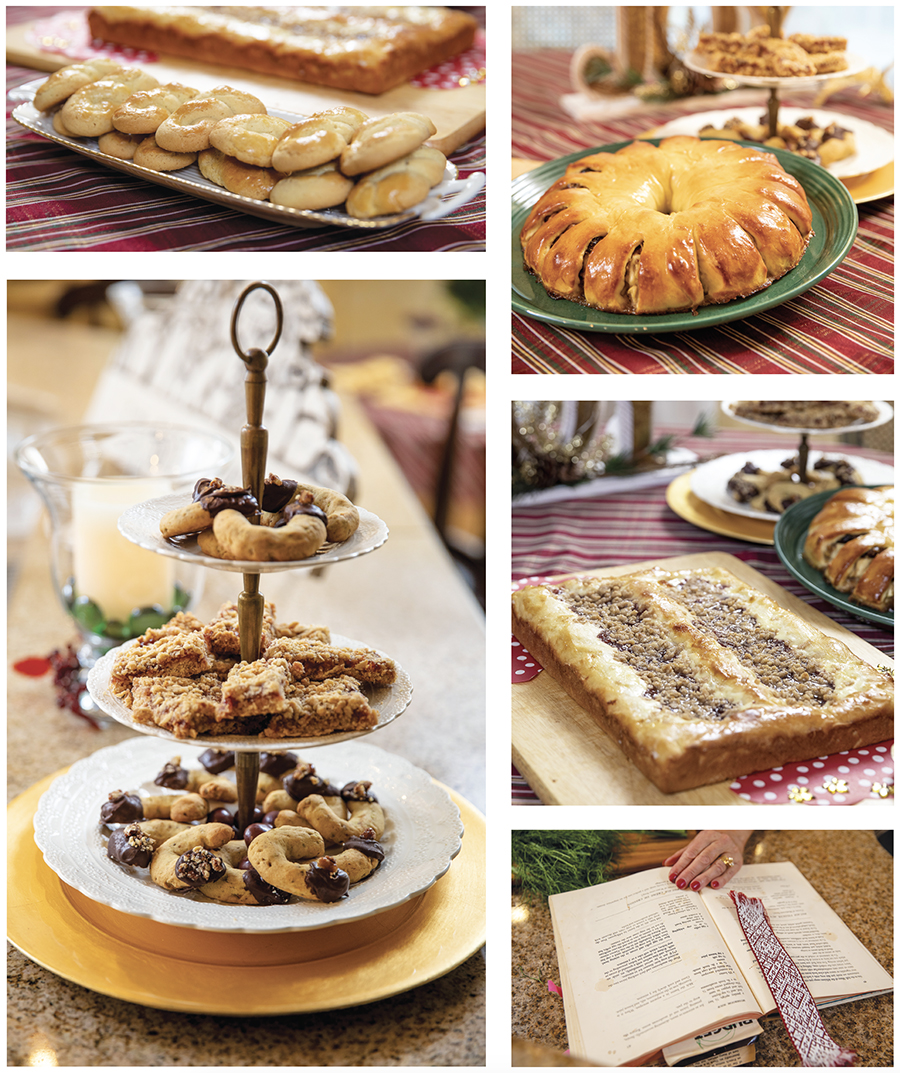
Karen Robbins brings French flair to her Greek and Italian culinary heritage – a portal into a rich multicultural world

By Cynthia Adams
Photographs by Bert VanderVeen
If the dogeared, heavily notated copy of Mastering the Art of French Cooking on Karen Robbins’ quartz counter doesn’t snag your attention, then the wafting aroma of sugar caramelizing with butter will. Knees have buckled at less. Luckily, there is a pot of fortifying coffee and a counter to lean into.
Welcome to Robbins’ kitchen, sporting a recent refresh, with the accent on functionality, which pleases the resident chef — the nifty pot filler addition isn’t just for looks. Neither is the new Wolf range nor the additional wall oven.
Delectable, magical things happen here. And it isn’t yet the holiday. She was baking for her mahjong club, which meets every Thursday evening.
Robbins smiles slyly. The baker and holiday enthusiast slides over a dish of toasty blueberry-and-peach “cutie pies” and plump peach scones. She waits.
Triple yum, I mumble impolitely, dribbling crumbs. Robbins’ eyes dance.
Long before Iron Chef, there was ubiquitous French Chef — Julia Child. Child’s televised programs initiated this Greek-Italian woman into French cooking.
(Robbins calls Child, “the Great One.”)

The two well-used volumes of Mastering the Art of French Cooking, which somebody gave her long ago, are key references.
“The recipes are long but very clear,” she says, thumbing through. There are many scribbles. “Sometimes I slightly alter or tweak Julia’s recipes, but her foundation is usually intact.”
In 2009, Robbins saw the popular film Julie & Julia. She related to the young blogger, Julie, who began cooking Child’s recipes and posting about it.
She recently rewatched the film.
“I loved it as much as I did the first time. Afterward, I got teary. I always liked to cook. But I remembered how much she, Julia, had meant and how I got started.”
She recalls early trials.
“I made her pastries with custard filling.” At the time, it was challenging. Now, “not so hard anymore.”
Robbins moved on to Child’s gigot à l’Anglaise (leg of lamb in red wine). Then the duck à l’orange.
Classics.
“Her lamb recipe has simple ingredients. I marinate and sliver all the pieces,” she explains. For caneton à l’orange, seasoning and trussing a whole duck was a bit more challenging, “but now, you can buy duck breasts versus the entire duck.” She grins.
“Simple ingredients.”
Not so simple a process.
But Robbins is not averse to simplification or improving the Great One’s process. Or variations.
Robbins’ eyes dart toward the window where she keeps basil and rosemary in boxes.
What for dinner?
“Yesterday, I made a filling of spanakopita and pesto and baked it as a crustless dish. Blended two cultures,” she smiles. “People liked it.”
Her husband has a saying whenever he truly loves something. “He says, ‘I’d pay for that,’” she laughs.
Robbins loves baking, saying it’s more exacting. “But cooking can be more creative.”
With the holidays here, Robbins is tickled just contemplating the meals and baking she will turn out of double ovens installed for this very purpose. She much favors the Wolf range’s convection oven for baking.
On this baking day, Robbins is all Zen-like and humming. She moves through her kitchen, her warm brown eyes shining as she runs through the flavor profiles for her holiday preparations.
“I can taste food in my head,” she says. “Not wines, but food.”
When Robbins, a former NYC speech therapist, retired and came South with her husband, Paul, they plunged headlong into retirement. Her husband is out playing golf on a golden morning. Their white Volvo sports the license plate “PAR 3”. She also golfs, but not when she can cook.
Baking, cooking and entertaining, three of her fundamental pleasures, just happened to have made her the hit of the Newcomer’s Club.
She enjoys a large, hydrangea-filled yard that backs up to an open country field. But the kitchen, which opens to a screened porch, is the beating heart of the traditional home.
The Mediterranean aspect traces to her family influences.
The gourmet kitchen already had furniture-style cabinetry but Robbins finally got the pot filler she always wanted, adding the Wolf gas range top and an additional wall oven for good measure. She already had a generously sized walk-in pantry, one that she has filled with canned tomatoes, “put up” herself.
Food has long been important in her family. With an Italian father and a Greek mother, how could food not be central to family life? Her parents, childhood friends, eloped when pressured not to marry outside the faith. Outsiders were called “goombahs” — pejorative slang for Italians. Friends but not family, Robbins clarifies.
Her Catholic father and Greek Orthodox mother had respective, entrenched traditions, especially when it came to food. “My mother learned to cook Italian,” Robbins explains. “What she made, she made well. But she wasn’t experimental.”
But her daughter discovered she was. Baking is an exact science, she stresses. But cooking isn’t.
It relaxed her.
Although Robbins had a serious career, she would look forward to cooking after work. Entertaining became her outlet. She did the whole bit, “from soup to nuts.”
Even the hardest effort was happiness-making. As for what is difficult now, Robbins pauses.
“The more involved things are probably”— and she breaks off to page through her sauce-bespattered French cookbook. “Hmm.”
“Some of the things are just not so hard anymore,” she muses. Duck, for instance: “I remember making it and the stove was billowing with smoke because of all the fat.”
A good friend who lectures on art history and culture aboard the Silversea cruise line invited her along on a cruise that ended in Nice, France. There, Robbins says she had one of the five most memorable meals of her life.
She inquired into a restaurant in walking distance of the hotel. “I went and ordered their duck. It was with peaches,” she says, pausing to conjure up the memory. “Oh my God, it was divine. And so, I got ahold of some duck breast and made my version with peaches, because this is the world of peaches. That was fun.”
In Mykonos, she enjoyed another memorable dish while awaiting the ferry — tomato pancakes cooked over a Bunsen burner. The pancakes “were insanely good.” Robbins worked until she reconstructed the recipe.
With sparkling brown eyes that widen as she recalls the experience, Robbins enthuses about the culinary surprises that travel brings.
“Food opens you to another avenue of the culture.”
In 2017, she and her husband took a week of cooking classes in the medieval Italian village of Castro dei Volsci in a gristmill before a cruise departing from Rome.
“I asked Paul, do you love me? He said, ‘Yes, of course.’ I said, how much in dollars, exactly?” She chuckles. “The cooking classes weren’t cheap.”
She learned to make proper risotto. “Even Paul got into making pizza, appetizers and desserts.”
Robbins views food as a portal into a rich, multicultural world — one she eagerly walks through. But coming South, the holidays required the eager cook to adapt to regional tastes. She was shocked to discover ham on Southern Thanksgiving menus. “It wasn’t something you ate for Thanksgiving in the North. If you didn’t like turkey, you did chicken. You only had ham at Christmas!”

Robbins baked and transported favorites to relatives outside the South. “I used to cook and take the food north,” she recalls. She even mastered a coconut custard pie originally requiring a three-day process. She simplified it to two.
Recently, Robbins adapted a Giada De Laurentiis recipe called “Thanksgiving for two.”
The experimental dish? “Ravioli made with Chinese dim sum stuffed with ground turkey, herbs and cranberry sauce.” It was close enough to pasta to satisfy her Italian taste buds.
“I grew up thinking everybody had pasta as their main meal at Christmas,” she confesses. “My mother made lasagna. Then we had roast beef. But we had fish Christmas Eve.”
For her Christmas meal, Robbins will make fresh homemade ricotta and manicotti using crepes instead of dried pasta.
For Christmas morning, she will bake a festive wreath cake with cream cheese and jam, adapted from an old Gourmet magazine. The recipe is butter-stained.
“It’s not hard if you’re going to bake — make a dough and roll it out.” She pauses. “It’s not level one,” she admits.
But neither is a Southern staple, she claims.
“I’ve never made a biscuit,” Robbins giggles. “That scares me!”
Yet, she bakes breads, biscotti and every manner of dessert, including pistachio cookies, which are beloved when she serves them to a large circle of friends she made in the Newcomer’s Club.
“All the men wanted the recipe — that I should give it to their wives!”
Some traditions are sacred. But . . . “Christmas almost needs to be tamed,” she notes. “My husband is very helpful. He helps with the gifts. There were a lot of Christmases when we moved here and we had to go up North. I was cooking. Packing. Buying and wrapping. I was so exhausted. It wasn’t fun.”
Their daughter and her family now live in North Carolina. When they arrive in Summerfield on Christmas morning, delectables await.
Robbins mentions shortcuts the Barefoot Contessa advocates, like not making all menu items from scratch.
Some recipes are so dear to her they are nearly perfect.
Others still require innovation; things she makes a lot because “it’s a test kitchen,” she smiles.
Robbins offers to get back to me on her five favorite culinary hits of all time. Things that Paul would pay for, she laughs.
Her brow knits.
And as she plots dinner, staples are at the ready. “I have fresh oregano, basil and thyme,” she says.
And a pantry stocked with freshly canned tomatoes.
For Robbins, with the rapidly approaching holidays, nothing says Christmas more than opening the taps to that pot filler for boiling noodles and revving up the sauce for fabulous, savory pasta-bilities. OH
For Karen Robbins’ recipes, please visit O.Henry magazines facebook page





